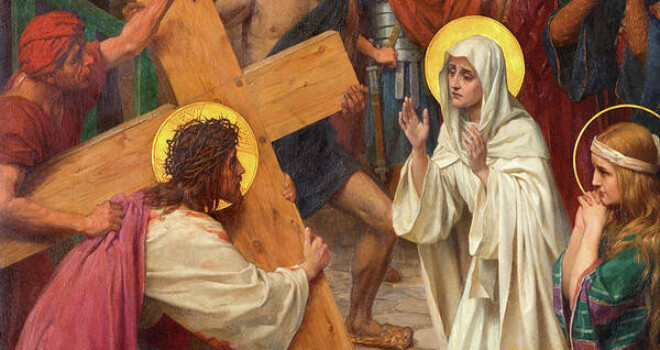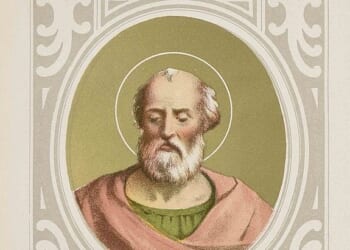In this series I have introduced the prayer, doce me passionem Tuam—teach me Your suffering—a simple aspiration we can pray many times a day. I also offered some suggestions on preparing during Lent for a Consecration to the Most Holy Cross of Jesus on Good Friday, which I will publish here during Holy Week. Today I would like to reflect on Mary’s participation in the Cross of Christ as a model for how each of us can more fully enter into Christ’s suffering, and in doing so, grow in union with Him.
As a psychiatrist, I have learned that one of the most difficult forms of suffering we encounter is the helpless experience of seeing a loved one suffer. Mary watched her Son suffer His Passion without being able to prevent that unspeakable horror. Despite her elevated status as the Mother of God, Our Lady was not spared suffering. But rather than begrudgingly enduring it, she embraced it for love of her Son.
Our Lady’s participation in Christ’s Cross began even before Jesus was born. Last month we celebrated the Solemnity of the Annunciation, when Mary gave God her fiat, her unconditional “yes” to God’s divine plan. In that consent, she freely gave God all that she had and all that she lacked; she emptied herself to make room for Him. From the first moment of the Incarnation, when Christ became a vulnerable human embryo in his Mother’s womb, the sign of the Cross was imprinted on Jesus’ entire life—and therefore, on His Mother’s entire life as well. Our Lord was born from the Cross and died on the Cross.
Just like the absurd and scandalous nature of His death, His birth was equally scandalous and absurd. No one pretending to be God would choose to be born in a cave and laid in a manger to an impoverished young woman and her husband because there was no room in the inn. We’ve grown so used to the story that we forget it’s a plan so very—for lack of a better word—insane that only God could have devised it. The Cross is not just found on Calvary; it’s found in the Nativity, and in all the moments of Christ’s life in between. The tender and beautiful love of Jesus in the manger is no different than the tender and beautiful love of Jesus on the Cross.
Mary left everything behind when she traveled from Nazareth to Bethlehem. She had no home there, no idea how this child would be born, or what would later happen to a child conceived of the Holy Spirit. She knew the Old Testament prophecies, but not precisely what her role would be, or what her life, St. Joseph’s life, and this baby’s life would entail. She placed everything—her hopes and her fears, her faith and her trust, her lack of knowledge or possessions or even a clear plan—entirely in God’s hands. She ventured out into the deep, risking everything, with her response, “Behold, the handmaid of the Lord; be it done unto me according to your word” (Lk. 1:38). Never has there been another creature who gave herself so fully and without reserve to the One she loved.
When she presented Jesus in the Temple and heard Simeon’s prophesy—that her Son would be a sign of contradiction and a sword would pierce her own soul—she accepted this future suffering without knowing what it would involve or how it would happen. When she then had to flee to Egypt with little but the clothes on her back, to live as a sojourner in a foreign land, she embraced this hardship to protect Our Lord, without knowing how they would survive or when they could return home. Twelve years later when the child Jesus was lost, Our Lady and St. Joseph worried in great distress about what had happened to Him, as any parent would: she didn’t have a crystal ball telling her to wait three days and then go and find Him in the Temple.
Later, when her Son was grown, she stood fast, without outrage or complaint, as Jesus endured a farcical trial and unjust sentencing. She witnessed His unspeakably brutal scourging, saw His sacred head crowned with thorns, watched Him carry the Cross, and ultimately, stood by Him as He was crucified. When she stood weeping at the foot of the Cross, and later held His lifeless and battered body, she did not know that in three days He would rise from the dead. She endured all this in faith, trusting in God’s plan without fully comprehending it.
Our Lady knew only that she wanted to accept, embrace, and live all that our Lord needed from her. But she did not know all of the particulars this would require: she was not given a clear blueprint from the outset. God took Mary’s consent, a simple but total, “Lord, I want to do your will,” and He gave her the capacity to give far more than she understood when she initially said yes. She consented to embrace Christ’s suffering when she gave God her fiat, even if she did not know the details in advance. Her consent expanded as she renewed this “yes” every day, constantly going deeper into the mystery of God’s will for her. This is why, though filled with anguish, Mary never despaired or cursed God while standing at the foot of the Cross.
Throughout her earthly life, Mary continuously took up her cross, but more significantly, she embraced Christ’s Cross. In doing so, Our Lady united herself to her Son through His suffering. While she stood at the foot of the Cross, as any mother who has watched her child endure an agonizing suffering can attest, Mary was figuratively nailed to the Cross with Him. As theologian Hans Urs Von Balthasar described it in his book of meditations on the Rosary: “The Mother’s body cannot help but feel what is done to her ‘fruit’. Because in a mysterious way Mary communes with the sufferings of her Son, she experiences in her own manner what is the sin of the world.” In other words, His suffering became hers.
It was there at the foot of the Cross that Mary’s vocation to be the exemplary heart of the Church was fulfilled, as Balthasar goes on to explain: “During the Passion and Mary’s hidden participation in it, there takes place her decisive transformation into the Church as Bride of the Lord.” The sword that pierces Mary’s heart (Lk. 2:35), prophesied decades earlier by Simeon, becomes the “echo within the Church” of the lance that pierces the heart of Christ (Jn. 19:34), from which the sacraments—the blood and water, the Eucharist and Baptism—flow.
Even following her Son’s Ascension into Heaven, Mary continued to carry the Cross of Christ in her Immaculate Heart, a heart already pierced and bared by Christ’s Passion. She still had to carry on with her life on earth, without his physical presence (save for his hidden presence in the Eucharist), until He finally called her home and crowned her Queen of Heaven. Christ’s own Mother—she who was without sin and who carried Him in her womb—was only able to achieve complete union with Him by embracing His suffering and becoming affixed to the Cross with Him. In this, she became the pierced heart, the preeminent exemplar, of the Church.
Likewise, only by participating in Christ’s suffering can our own take on meaning—indeed, can even become a gift—as difficult as this might be for us to accept. This is the mystery of our participation in the Cross of Christ. The most powerful antidote to our suffering comes not when we focus on our own pain, but when we ask Jesus to teach us His—when we learn His suffering as Our Lady did. This is the heart of this little prayer, doce me passionem Tuam—teach me Your suffering.
Author’s Note: This is Part 6 in a weekly Lenten series on the Christian meaning of suffering and the Cross of Christ. All other articles of the series can be read here.
Image available from Fine Art America















